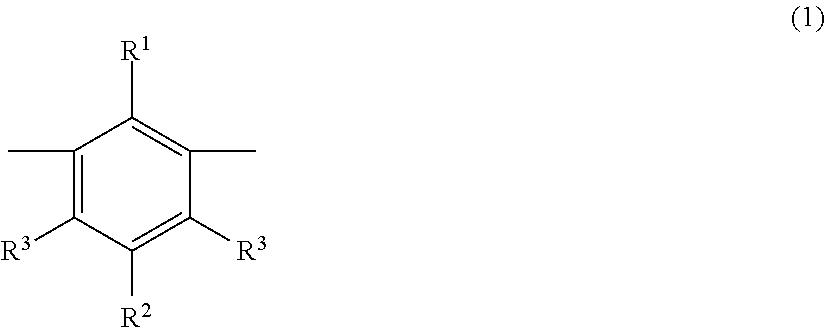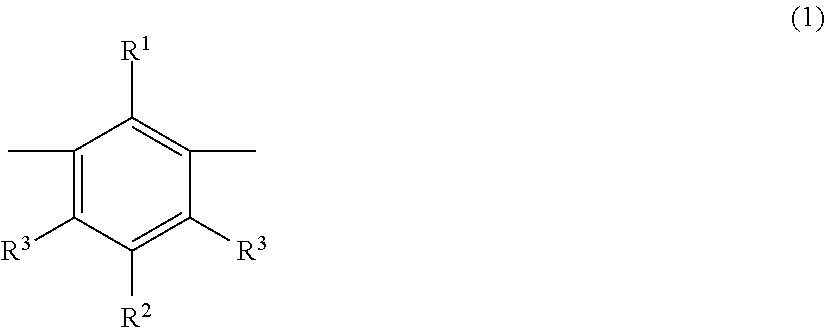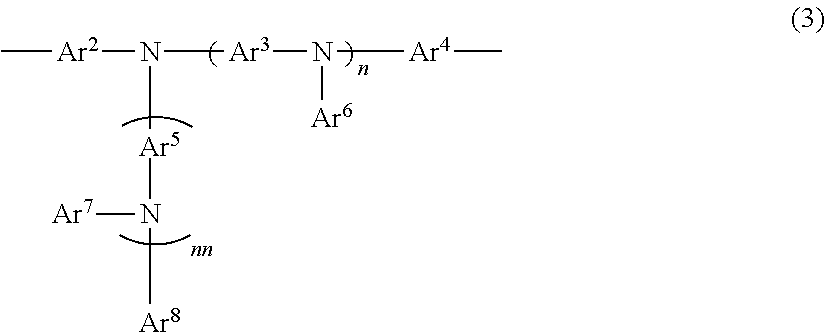Metaphenylene polymer compound and light emitting device using the same
a technology of metal phenylene polymer compound and light emitting device, which is applied in the direction of thermoelectric device junction materials, solid-state devices, light sources, etc., can solve the problem of insufficient maximum light emission efficiency of the resultant light emitting device, and achieve excellent maximum light emission efficiency
- Summary
- Abstract
- Description
- Claims
- Application Information
AI Technical Summary
Benefits of technology
Problems solved by technology
Method used
Image
Examples
example 1
Synthesis of Compound M1
[0206]
(Step (1a))
[0207]Under an argon gas atmosphere, 3,5-dibromo-4-methylaniline (47.0 g, 177 mmol), 35 wt % hydrochloric acid (111 ml) and ion exchanged water (111 ml) were mixed in a 1000 ml flask and cooled in an ice bath, and a solution prepared by dissolving sodium nitrite (12.9 g, 186 mmol) in ion exchanged water (about 130 ml) was dropped into the cooled mixture over a period of about 30 minutes. After completion of dropping, the mixture was stirred at room temperature for about 1 hour, then, cooled in an ice bath again, then, a solution prepared by dissolving potassium iodide (30.9 g, 186 mmol) in ion exchanged water (about 130 ml) was dropped into the cooled mixture over a period of 30 minutes. After completion of dropping, the mixture was stirred at room temperature for about 3 hours, then, added slowly to a separately prepared 10 wt % sodium hydrogen carbonate aqueous solution (about 1200 ml) while stirring. Ethyl acetate (about 1000 ml) was added...
example 2
Synthesis of Compound M2
[0211]
(Step (2a))
[0212]Under an argon gas atmosphere, a compound M1a (18.8 g, 50.0 mmol), 4-tolueneboronic acid (6.80 g, 50.0 mmol), tetrakis(triphenylphosphine)palladium(0) (2.89 g, 2.5 mmol), silver carbonate (27.6 g, 100 mmol) and dehydrated tetrahydrofuran (500 ml) were mixed, and stirred at room temperature for 1 hour under shading, then, heated up to 50° C. and further stirred for 2 hours. The mixture was cooled down to room temperature, then, diluted with hexane (about 1000 ml), and passed through a filter matted with celite to remove insoluble materials. The filtrate was concentrated, and to the resultant solid was added methanol (about 1500 ml), and the mixture was stirred for 30 minutes under reflux with heating, then, the mixture was cooled down to room temperature, and passed through a filter matted with celite to remove insoluble materials. The filtrate was concentrated, and purified by middle pressure silica gel column chromatography (hexane), t...
example 3
Synthesis of Compound M3
[0214]
(Step (3a))
[0215]Under an argon gas atmosphere, a compound M2 (11.22 g, 33.0 mmol), bis(pinacolato)diborane (25.14 g, 99 mmol), [1,1′-bis(diphenylphosphino)ferrocene]dichloropalladium(II) (1.35 g, 1.65 mmol), 1,1′-bis(diphenylphosphino)ferrocene (0.91 g, 1.65 mmol), potassium acetate (9.72 g, 99 mmol) and dehydrated 1,4-dioxane (264 ml) were mixed, and stirred for about 13 hours under reflux with heating, and further allowed to stand still at room temperature for 10 hours. The mixture was again stirred for 1 hour under reflux with heating, then, bis(pinacolato)diborane (1.68 g, 6.6 mmol) was added, and the mixture was further stirred for 3 hours under reflux with heating. The mixture was cooled down to room temperature, then, insoluble materials were filtrated off, and the residue was concentrated until the content was about 70 g, and hexane (about 500 ml) was added and the mixture was stirred for 1 hour at room temperature. As a result, black solid was...
PUM
| Property | Measurement | Unit |
|---|---|---|
| triplet excitation energy | aaaaa | aaaaa |
| T1 energy | aaaaa | aaaaa |
| emission color | aaaaa | aaaaa |
Abstract
Description
Claims
Application Information
 Login to View More
Login to View More - R&D
- Intellectual Property
- Life Sciences
- Materials
- Tech Scout
- Unparalleled Data Quality
- Higher Quality Content
- 60% Fewer Hallucinations
Browse by: Latest US Patents, China's latest patents, Technical Efficacy Thesaurus, Application Domain, Technology Topic, Popular Technical Reports.
© 2025 PatSnap. All rights reserved.Legal|Privacy policy|Modern Slavery Act Transparency Statement|Sitemap|About US| Contact US: help@patsnap.com



